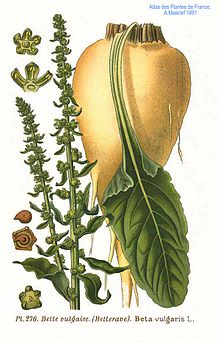This article needs additional citations for verification. (February 2021) |
| Sugar beet | |
|---|---|
 Sugar beet, illustration of root, leaf, and flowering patterns | |
| Species | Beta vulgaris |
| Subspecies | Beta vulgaris subsp. vulgaris (var. saccharifera) |
| Cultivar group | Altissima Group |
| Origin | Silesia, mid-18th century |
A sugar beet is a plant whose root contains a high concentration of sucrose and that is grown commercially for sugar production. In plant breeding, it is known as the Altissima cultivar group of the common beet (Beta vulgaris).[1] Together with other beet cultivars, such as beetroot and chard, it belongs to the subspecies Beta vulgaris subsp. vulgaris but classified as var. saccharifera . Its closest wild relative is the sea beet (Beta vulgaris subsp. maritima).[2]
Sugar beets are grown in climates that are too cold for sugarcane. In 2020, Russia, the United States, Germany, France and Turkey were the world's five largest sugar beet producers.[3] In 2010–2011, Europe, and North America except Arctic territories failed to supply the overall domestic demand for sugar and were all net importers of sugar.[4] The US harvested 1,004,600 acres (406,547 ha) of sugar beets in 2008.[5] In 2009, sugar beets accounted for 20% of the world's sugar production[6] and nearly 30% by 2013.[7] Sugarcane accounts for most of the rest of sugar produced globally. In February 2015, a USDA factsheet reported that sugar beets generally account for about 55 percent of domestically produced sugar, and sugar cane for about 45 percent.[8]
- ^ Cite error: The named reference
MMPNDwas invoked but never defined (see the help page). - ^ Cite error: The named reference
springerwas invoked but never defined (see the help page). - ^ Cite error: The named reference
faowas invoked but never defined (see the help page). - ^ Cite error: The named reference
usdawas invoked but never defined (see the help page). - ^ Cite error: The named reference
usda2was invoked but never defined (see the help page). - ^ Cite error: The named reference
agrisugar1was invoked but never defined (see the help page). - ^ Cite error: The named reference
Dohm-et-al-2013was invoked but never defined (see the help page). - ^ Cite error: The named reference
usda4was invoked but never defined (see the help page).